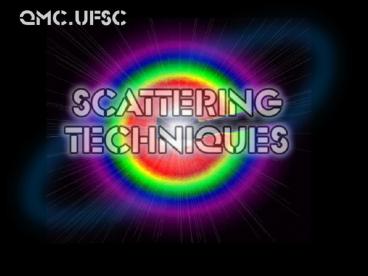Slide sem ttulo PowerPoint PPT Presentation
1 / 31
Title: Slide sem ttulo
1
(No Transcript)
2
(No Transcript)
3
Inelastic Scattering
Raman
Compton
4
Acoustic Mode Scattering
Bragg and Brillouin
5
Why the sky is blue?
6
Rayleigh Scattering
Rayleigh scattering refers to the scattering of
light off of the molecules of the air, and can be
extended to scattering from particles up to about
a tenth of the wavelength of the light.
7
Mie Scattering
The scattering from molecules and very tiny
particles (lt 1 /10 wavelength) is predominantly
Rayleigh scattering. For particle sizes larger
than a wavelength, Mie scattering predominates.
8
Mie scattering is not strongly wavelength
dependent and produces the almost white glare
around the sun when a lot of particulate material
is present in the air. It also gives us the the
white light from mist and fog.
9
SAXS/WAXS WAXS DLS SLS SALS
Photons
Rayleigh Scattering
Neutrons
SANS SPIN-ECHO
10
ESRF- EUROPEAN SYNCHROTRON RADIATION
FACILITIES X-RAYS SOURCE
ILL INSTITUT LAUE LANGEVIN NEUTRONS SOURCE
ESRF RING
ILL REACTOR
GRENOBLE, FRANCE
11
Elastic and Quasi-Elastic Light Scattering
Elastic Mw, Rg, A2 , form factor P(q),
Persistence Length, etc. Dynamic relaxation
times, Diffusion Coefficients, Mobilities, etc.
12
SAXS/WAXS X-Ray Scattering
2-D detector up to 600 Å resolution
Nano-Structures x-rays Scattering Form factor,
Anisotropy, Polyelectrolytes, Nano-materials
Copolymers, Colloids, Micelles, Polymer Liquid
Crystals, etc.
13
Intensity vs wavevector q
Elastic Scattering
Size and Shape
Mw (Molecular Weight Rg (Radius of Gyration) A2
(Virial Coefficient)
o-1
q(A
)
Light scattering, SANS, SAXS
Dynamic Scattering Diffusion Coefficient D
or Hydrodynamic Radius Rh
14
(No Transcript)
15
SALT-FREE POLYELECTROLYTE CHAINS (Electrostatic
Forces)
SAXS
REPULSION
Scattering Peak !
Expansion of the Chain
q
o-1
q(A
)
16
(1/3) Uniform / Cubic Arrangement
(1/2) Cylindrical 2-D Arrangement
17
XANTHAN/LS/SAXS
q-SAXS Range
)
-1
(A
max
q
0.497
q
0.34C
max
q-Light Scattering Range
3
C (g/cm
)
E. Sadlik, M. Villetti, M. de Souza, V. Soldi and
R. Borsali (in preparation )
18
(No Transcript)
19
The wave-vector q
20
Quasi-Elastic Light Scattering or... SLS - Static
Light Scattering
The amount of light scattered is directly
proportional to the product of the weight-average
molar mass and the macromolecule (solute)
concentration, i.e., LS Mwc
R(Q) is the excess intensity of scattered light
at angle Q c is the sample concentration Mw is
the weight-average molecular weight (molar mass)
A2 is a second viral coefficient K is an
optical parameter equal to 4p2n2 (dn/dc)2 /
(lo4NA) n is the solvent refractive index and
dn/dc is the refractive index increment NA is
Avogadros number lo is the wavelength of the
scattered light in vacuum.
Based on Zimms formalism, the Rayleigh-Debye-Gans
light scattering model for dilute polymer
solutions can be expressed as equation below
21
The function P(Q) describes the angular
dependence of scattered light. The expansion of
1/ P(Q) to first order gives 1/ P(Q) 1
(16p2/3l2) ltrg2gt. sin2(Q/2) f4 sin4(Q/2) ...
At low angles the angular dependence of light
scattering depends only on the mean square radius
ltrg2gt (alternatively called radius of gyration)
and is independent of molecular conformation or
branching. Zimm plot A plot of Kc /R(Q) vs.
sin2(Q/2) yields a curve whose intercept gives
Mw and whose slope at low angles gives ltrg2gt.
22
ZIMM DIAGRAM
KC/I(q) (1/Mw)(1q2Rg2/3) 2A2C
KC/I(q)
C-gt0
KC/I(q) (1/M) (q -gt0 C -gt0)
KC/I(q) (1/M)(1q2Rg2/3) (C -gt0)
b -gt Slope Rg2/3M
q-gt0
b
KC/I (1/Mw) 2A2C (q-gt0)
a
a -gt Slope 2A2
C2
C1
C4
C3
(1/M)
q2kC
Measure of I(q) as a function of
Concentration and Scattering Angle allows the
determination of The Molecular Weight Mw The
Radius of Gyration Rg The Second Virial
Coefficient A2 The Form Factor P(q)
23
PVP 30 mM
24
(No Transcript)
25
O coeficiente viral A2
HA0.1mg/mL
PVP30mM SDS7mM
26
Photon Correlation Spectroscopy or... DLS -
Dynamic Light Scattering
27
(No Transcript)
28
Solvent
Polymer solution
29
DYNAMIC LIGHT SCATTERING Linear Cyclic PS-PI in
heptane
30
(No Transcript)
31
Stokes Einstein equation

